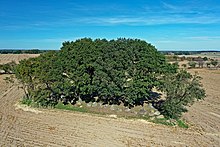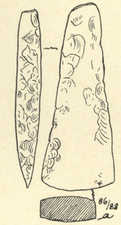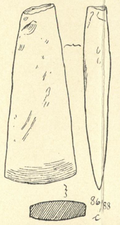Great stone graves near Drebenstedt
| Great stone graves near Drebenstedt Bunny oven (grave 5) | ||
|---|---|---|
|
Great stone grave Drebenstedt 1 |
||
|
|
||
| Coordinates | 52 ° 43 '14.3 " N , 10 ° 53' 39.6" E | |
| place | Jübar , Saxony-Anhalt , Germany | |
| Emergence | 3700 to 3350 BC Chr. | |
The megalithic graves near Drebenstedt were originally five megalithic graves of the Neolithic deep-engraving ceramic culture near Drebenstedt , a district of the Jübar community in the Altmark district of Salzwedel , Saxony-Anhalt . There is only one left today. It is one of the largest and best preserved large stone graves in the Altmark . The other four graves were destroyed in the 19th century.
location
The preserved grave 1 is located 950 m west of the center of Drebenstedt, south of the road to Lindhof in a field. Grave 2 was 40 paces (approx. 30 m) east of this. Grave 3 was 300 paces (approx. 230 m) southeast of grave 2. Grave 4 was another 100 paces (approx. 75 m) east and grave 5 another 40 paces (approx. 30 m) east.
There are several other large stone graves in the vicinity. The megalithic graves are located 1.8 km southeast of the preserved complex near Bornsen . 2 km to the northwest is the Molmke large stone grave (one of the original at least ten structures that have been preserved) and the large stone graves at Diesdorf are located 2.6 km to the northwest .
Research history
Due to its size and good preservation, grave 1 attracted the interest of numerous researchers in the 19th century, including Rudolf Virchow . Descriptions of the grave were provided by Johann Friedrich Danneil in 1843, who called it the “most imposing giant bed in the Altmark”, Hermann Dietrichs and Ludolf Parisius in 1883 and Eduard Krause and Otto Schoetensack in 1893. Danneil and Krause and Schoetensack were the first to determine the volume and mass of the stones used. Ethnographic and experimental archaeological investigations later made it possible to use this data to determine the workload for the large stone grave. According to the calculations, this amounted to 37,535 person- hours , i.e. H. in a 10-hour working day, 100 people were able to erect the grave in 35 to 40 days.
The remaining graves were also partially examined before they were destroyed, with some discoveries being made.
In 2003-04, all remaining large stone graves in the Altmark were recorded and measured as a joint project of the State Office for Monument Preservation and Archeology of Saxony-Anhalt , the Johann Friedrich Danneil Museum in Salzwedel and the association “Young Archaeologists of the Altmark”.
description
The preserved grave 1
The grave belongs to the large dolmen type . The mound is elongated and measures 47.0 m × 10.0 m, its height is 1.7 m. It flowed only minimally over the grave border. The enclosure is oriented northwest-southeast and trapezoidal. They are 43.8 m long and 6.0–7.5 m wide. Of the original 58 surrounding stones, 53 are still preserved today. In the northwest, where the burial chamber is located, the enclosing stones are significantly larger than in the southeast. Originally there were guard stones at the four corners of the enclosure . These are all still there, but three of them have now passed over. The one that is still standing is on the west corner and measures 2.4 m × 2.1 m × 0.7 m. The two guard stones on the southeast side stood in front of the actual enclosure, while those on the northwest side belong to the enclosure itself and thus form corner stones. The southwestern guard stone has several round and oval bowls on its upper side . A surrounding stone on the northeast side has a 6 cm wide and up to 5 cm deep semicircular channel. The stone directly opposite it on the southwest side also has at least one channel. It is 3 cm wide, 3 cm deep and horseshoe-shaped. A possibly existing second channel is now hardly recognizable.
The burial chamber is oriented northwest-southeast and is located in the northwest part of the enclosure. It originally consisted of 16 wall stones, 13 of which have survived, and five cap stones. A capstone is broken. The two largest cap stones measure 2.5 m × 2.0 m × 1.0 m and 2.7 m × at least 1.2 m × 0.5 m. The chamber is rectangular and has the internal dimensions 8.8 m × 1.9 m.
- Large stone grave Drebenstedt 1, details
Destroyed graves
Grave 2
According to Danneil, grave 2 had a burial chamber with a length of 10 m and a width of 3.1 m. It had four cap stones. The exact type of grave cannot be determined with certainty on the basis of this description, but due to the size it must have been a large dolmen or a passage grave. A stone enclosure seems to have originally existed, but was already missing when Danneil took it.
Grave 3
Grave 3 was 6.3 m long and 5 m wide. When Danneil examined it, there was still a capstone that had slipped off one side of the stone wall. The exact type of grave can no longer be determined.
Grave 4
Grave 4 was already badly damaged when Danneil was taken. The plant was 10 m long and 4.4 m wide. The exact type of grave can no longer be determined.
Grave 5
Grave 5 was popularly called "rabbit oven" after Danneil. It was already so badly damaged that even its dimensions could not be determined. The exact type of grave can no longer be determined either.
Finds
In the collection of Johann Friedrich Danneil Museum in Salzwedel are four Feuerstein - axes and a narrow chisel , which date from the megalithic tombs at Drebenstedt. Two axes were found in graves 4 and 5, the rest of the devices are from graves 1 and 3
- Four axes and a narrow chisel from the graves near Drebenstedt
See also
literature
- Hans-Jürgen Beier : The megalithic, submegalithic and pseudomegalithic buildings as well as the menhirs between the Baltic Sea and the Thuringian Forest. Contributions to the prehistory and early history of Central Europe 1. Wilkau-Haßlau 1991, p. 56.
- Wilhelm Blasius : Guide to the megalithic grave monuments in the western part of the Salzwedel district. In: Thirty-first annual report of the Altmark Association for Patriotic History and Industry. Issue 2, 1904, p. 102 ( PDF; 8.1 MB ).
- Hartmut Bock , Barbara Fritsch, Lothar Mittag: Great stone graves of the Altmark . State Office for Monument Preservation and Archeology Saxony-Anhalt and State Museum for Prehistory, Halle (Saale) 2006, ISBN 3-939414-03-4 , pp. 77–81, 209–211.
- Johann Friedrich Danneil : Special evidence of the barrows in the Altmark . In: Sixth annual report of the Altmark Association for Patriotic History and Industry . 1843, pp. 103-104 ( PDF; 5.5 MB ).
- Hermann Dietrichs , Ludolf Parisius : Pictures from the Altmark. First and second volume. Hamburg 1883, pp. 275-276 ( online ).
- Hans-Ulrich Kelch: Mysterious pans. In: Hartmut Bock (Ed.): Cities - Villages - Friedhöfe. Archeology in the Altmark 2: From the High Middle Ages to the modern age (= contributions to the cultural history of the Altmark and its peripheral areas, Volume 8). Oschersleben 2002, ISBN 3-935358-36-9 , p. 459.
- Eduard Krause , Otto Schoetensack : The megalithic graves (stone chamber graves) of Germany . I .: Altmark . In: Journal of Ethnology . Vol. 25, 1893, p. 147 / no. 86, Plates VI / 86, VII / 86, IX / 86 ( PDF; 39.0 MB ).
- Britta Schulze-Thulin : Large stone graves and menhirs. Saxony-Anhalt • Thuringia • Saxony . Mitteldeutscher Verlag, Halle (Saale) 2007, ISBN 978-3-89812-428-7 , p. 43.
Web links
- The Megalithic Portal: Drebenstedt long bed
- KLEKs Online: Drebenstedt large stone grave
- grosssteingraeber.de: The Drebenstedt large stone grave near Salzwedel
- strahlen.org: "Drebenstedt" stone grave, Drebenstedt near Salzwedel, Altmark
- cruptorix.nl: Drebenstedt 2
Individual evidence
- ↑ Hartmut Bock, Barbara Fritsch, Lothar Mittag: Großsteingraves der Altmark. 2006, p. 78
- ↑ Hartmut Bock, Barbara Fritsch, Lothar Mittag: Großsteingraves der Altmark. 2006, pp. 209-211
- ↑ Hartmut Bock, Barbara Fritsch, Lothar Mittag: Großsteingraves der Altmark. 2006, p. 11.
- ↑ Hartmut Bock, Barbara Fritsch, Lothar Mittag: Großsteingraves der Altmark. 2006, pp. 77-78










